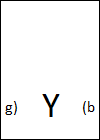Norsaga Game Design, Part 1
Kevin Bishop
This is the first in a series of articles tracing the design of Norsaga's core gameplay loop and mechanical balance. To see where it ends up, check out the rules document on the main site.
If you checked out Norsaga at Gen Con, you've seen how the game turned out in its final form. Now I'd like to tell you the story behind it: how Norsaga evolved from concept, to playtest, to tuning and balance. Today I'll talk about that first step: the game's original concept, starting at the moment it crystallized from random ideas into an actual design document.
Norsaga has always been a game about storytelling. It arose from a mental image of this card layout concept:
This "goal card" is very similar to the saga cards in the final game, but much more ambitious. Just as real stories are open to interpretation, each goal card would have two ways to complete it. One player claims they killed the dragon; someone else, that they domesticated it. Who's telling the truth? The winner, of course.
You can also see another abandoned concept at work here. By laying a second saga orthogonally beneath the first, players 3 and 4 can try to do other things to the dragon, creating a humorous juxtaposition as the "endings" get applied to sagas they weren't intended for.
Finally, anyone familiar with the final game will notice that the sagas have 7 traits shown instead of 6. More on that later.
Believe it or not, the rest of Norsaga followed from this idea. How do you prove you slew the dragon? Well, it must require certain traits. How do you prove you have these traits? Create an ancestry from cards which possess them. One mental image of a family tree later and Tada! the first hero card layout was born:
Aside: The first playtest cards were printed on A4 paper at this actual size. Tiny non-rigid cards are a nightmare to play with--and to shuffle.
If you're doing the math (and as a designer, you should be), you'll extrapolate a few things here:
- The sagas shown above have 7 dots spread across 4 colors. There are 120 permutations, with 2 per card, leading to 60 distinct saga cards.
- The first hero cards could have different recessive traits on each side. With 4 colors, you have 4x4x4 = 64 different hero cards.
To flesh out the hero card roster, I added some stipulations:
- Hero traits could also be blank, effectively adding a 5th color. There are now 5x5x5 = 125 cards.
- Remove the all-blank card and any card with both a blank dominant and one blank recessive trait. This cuts out 9 more cards, for a total of 116.
- Player family trees can have 7 cards on them. In a 4 player game, 24% of the cards will be in play at a time, and another 10% will be in players' hands (original hand size was 3 cards).
All of this design, such as it is, gave me enough confidence in the raw numbers that I was ready to print out some playtest cards. Not so fast! So far it's little more than a color-matching card game. It still needed an element of strategy.
One or two rounds of experimentation lead to the idea that your family tree's dominant heritage would allow you to pull off feats of storytelling prowess. Queue the original concept for embellishments:
Spoiler alert! Even at this early stage, you can see that 75% of the embellishments are close to their final forms. A lot of shuffling took place over the intervening months, but it eventually proved true that many of the most "obvious" concepts for embellishments were also the most viable.
Another abandoned mechanic is visible here: the 4th-level "full-blooded" embellishments. These were activated by having a shared color across your youngest hero, your parents, and both pairs of grandparents.
At this early stage of the design, it was still unclear whether embellishments were always "powers" that you actively used, or "passives" that could affect the game statically and perpetually.
And there you have it: the components of Norsaga that were codified and printed out on Day 1. I took them to a friend's house, played a few rounds... and returned home, much wiser.
To learn more about how the game evolved after the first playtest, check back next week!



